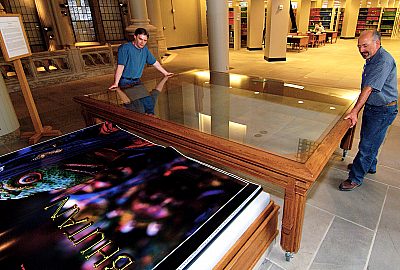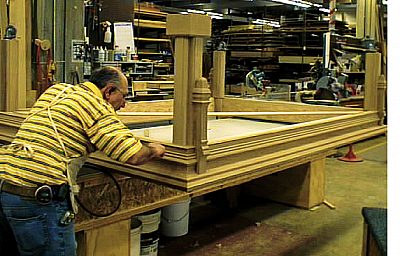May 12, 2005
World’s biggest book gets perfect place to lay its spine
The order from Suzzallo Library sounded simple: Build them a bookcase. But this wasn’t just any bookcase; this was a case to hold the biggest book in the world — a book that opens to 5 by 7 feet and weighs 133 pounds.
The book, Bhutan: A Visual Odyssey across the Last Himalayan Kingdom, had been assembled from a collection of photos taken on trips to Bhutan by MIT Professor Michael Hawley and had been purchased for the UW Libraries by Kevin Schofield a little more than a year ago. Since then it’s been in storage because the library had no suitable display space for it.
That’s why Sandra Kroupa, book arts and rare book curator for the libraries, met with Ed McKinley, carpenter lead in Facilities Services, to explain what was needed to protect the book while allowing the public to see it.
“The first problem is the book’s weight,” Kroupa said. “It has to be displayed flat or the pages will begin to pull away from the spine.”
But that was only the beginning. The book also had to be protected from UV light — meaning it needed a glass covering — and the case needed to be adjustable, so that the book could be close enough to the glass to be seen, then moved far enough away to turn the pages periodically. And finally, the case had to fit into the Gothic setting chosen for it — right outside Suzzallo’s Reading Room.
McKinley pondered the requirements and told Kroupa he thought his shop was up to the challenge. Back at his desk, he fired up his Computer Aided Design program and began to work.
“The hardest part was making the case adjustable,” McKinley said. “The book had to be raised and lowered — close to the glass for display, further away to turn the pages.”
So McKinley designed a two-piece case. There was a platform on which the book sat and a “canopy” consisting of a sort of glass-topped table with legs. Inside the platform is what McKinley calls a scissor lift. Made of 16 gauge steel framing strut, it includes two linear actuators (electric motors) with limiting switches, so that when turned on it raises or lowers a specific distance and then stops.
When it’s time to turn the book’s pages, a librarian turns the key-operated switch and the book lowers. The canopy is then slid horizontally on castors, exposing the book. The page can then be turned and the process repeated in reverse.
To protect the book’s spine, the platform has two cushions with a space in between where the spine sits. That way, the entire book is flat and the heavy pages aren’t constantly pulling away from the spine.
So much for the mechanics. But the case also had to look good. “We didn’t want any metal or laminate,” Kroupa said. “We wanted to pick up the architectural detail of the Reading Room.”
So McKinley came to the library with Carmine Ruggiero, a UW carpenter with a lot of experience in custom cabinetry. They measured the molding on the Reading Room’s bookshelves, and Ruggiero made a paper model. Then Ruggiero went to work.
He used quarter-sawn oak, the same material in the Reading Room, and copied the intricate molding by grinding his own shaper cutters, then using these to cut the correct shapes into the wood. One piece of the molding required six different cutters.
Did he practice on something else before using the precious — and expensive — oak? “No,” Ruggiero said. “I’ve done this kind of thing so many times.”
But he admits he did make an extra piece of molding, just in case.
Once the cabinet was completed and a finish hand brushed on it by painter Danette Rogers, the next problem was to get it into Suzzallo. The shop crew was able to get the canopy onto the rack of their pickup truck, McKinley said, but he had to climb in the window to drive because the doors wouldn’t open. It took five men to carry the canopy into the library. Then they used a kind of padded plywood sled Ruggiero had made to alternately lift and drag it up the steps. The platform came in the same way, followed by the glass, which made the trip on the glass shop’s specially equipped truck.
“We put it in place, and pop, it was good,” McKinley said. “It looked like it belonged there.”
The librarians thought so too. “We’ve been very pleased with it,” Kroupa said. “Mechanically, it works very well.”
The book in its case can be seen any time by climbing Suzzallo’s grand staircase and walking toward the Reading room. Kroupa says the pages will be turned from time to time on no particular schedule.
As for McKinley Ruggiero and Rogers, they’re back to their more typical tasks of making podiums, cabinets and counter tops for labs and more standard bookshelves.
“It’s not often that we get a project that’s this challenging and fun,” McKinley said. “We were glad for the opportunity.”




